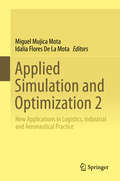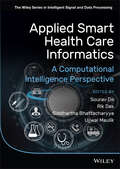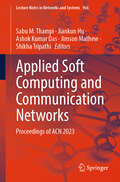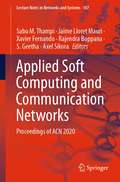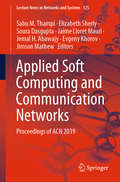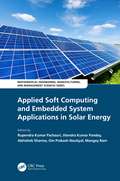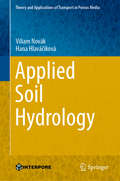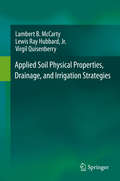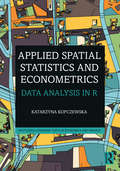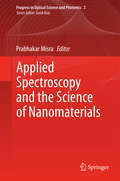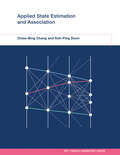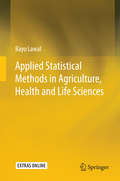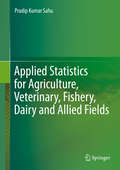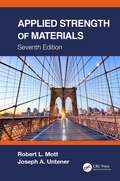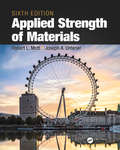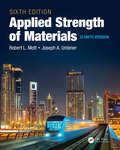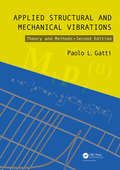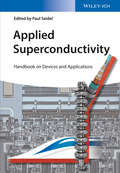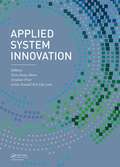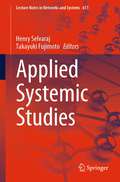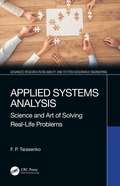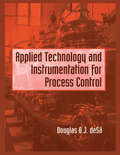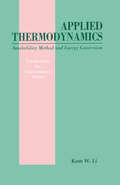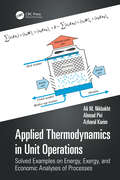- Table View
- List View
Applied Simulation and Optimization: In Logistics, Industrial and Aeronautical Practice
by Miguel Mujica Mota Idalia Flores De La Mota Daniel Guimarans SerranoPresenting techniques, case-studies and methodologies that combine the use of simulation approaches with optimization techniques for facing problems in manufacturing, logistics, or aeronautical problems, this book provides solutions to common industrial problems in several fields, which range from manufacturing to aviation problems, where the common denominator is the combination of simulation's flexibility with optimization techniques' robustness. Providing readers with a comprehensive guide to tackle similar issues in industrial environments, this text explores novel ways to face industrial problems through hybrid approaches (simulation-optimization) that benefit from the advantages of both paradigms, in order to give solutions to important problems in service industry, production processes, or supply chains, such as scheduling, routing problems and resource allocations, among others.
Applied Simulation and Optimization 2: New Applications in Logistics, Industrial and Aeronautical Practice
by Miguel Mujica Mota Idalia Flores De La MotaBuilding on the author's earlier Applied Simulation and Optimization, this book presents novel methods for solving problems in industry, based on hybrid simulation-optimization approaches that combine the advantages of both paradigms. The book serves as a comprehensive guide to tackling scheduling, routing problems, resource allocations and other issues in industrial environments, the service industry, production processes, or supply chains and aviation. Logistics, manufacturing and operational problems can either be modelled using optimization techniques or approaches based on simulation methodologies. Optimization techniques have the advantage of performing efficiently when the problems are properly defined, but they are often developed through rigid representations that do not include or accurately represent the stochasticity inherent in real systems. Furthermore, important information is lost during the abstraction process to fit each problem into the optimization technique. On the other hand, simulation approaches possess high description levels, but the optimization is generally performed through sampling of all the possible configurations of the system. The methods explored in this book are of use to researchers and practising engineers in fields ranging from supply chains to the aviation industry.
Applied Smart Health Care Informatics: A Computational Intelligence Perspective (The Wiley Series in Intelligent Signal and Data Processing)
by Sourav DeApplied Smart Health Care Informatics Explores how intelligent systems offer new opportunities for optimizing the acquisition, storage, retrieval, and use of information in healthcare Applied Smart Health Care Informatics explores how health information technology and intelligent systems can be integrated and deployed to enhance healthcare management. Edited and authored by leading experts in the field, this timely volume introduces modern approaches for managing existing data in the healthcare sector by utilizing artificial intelligence (AI), meta-heuristic algorithms, deep learning, the Internet of Things (IoT), and other smart technologies. Detailed chapters review advances in areas including machine learning, computer vision, and soft computing techniques, and discuss various applications of healthcare management systems such as medical imaging, electronic medical records (EMR), and drug development assistance. Throughout the text, the authors propose new research directions and highlight the smart technologies that are central to establishing proactive health management, supporting enhanced coordination of care, and improving the overall quality of healthcare services. Provides an overview of different deep learning applications for intelligent healthcare informatics management Describes novel methodologies and emerging trends in artificial intelligence and computational intelligence and their relevance to health information engineering and management Proposes IoT solutions that disseminate essential medical information for intelligent healthcare management Discusses mobile-based healthcare management, content-based image retrieval, and computer-aided diagnosis using machine and deep learning techniques Examines the use of exploratory data analysis in intelligent healthcare informatics systems Applied Smart Health Care Informatics: A Computational Intelligence Perspective is an invaluable text for graduate students, postdoctoral researchers, academic lecturers, and industry professionals working in the area of healthcare and intelligent soft computing.
Applied Soft Computing and Communication Networks: Proceedings of ACN 2023 (Lecture Notes in Networks and Systems #966)
by Jimson Mathew Sabu M. Thampi Jiankun Hu Ashok Kumar Das Shikha TripathiThis book constitutes thoroughly refereed post-conference proceedings of the International Applied Soft Computing and Communication Networks (ACN 2023) held at PES University, Bangalore, India, during December 18–20, 2023. The research papers presented were carefully reviewed and selected from several initial submissions. The papers are organized in topical sections on security and privacy, network management and software-defined networks, Internet of Things (IoT) and cyber-physical systems, intelligent distributed systems, mobile computing and vehicle communications, and emerging topics. The book is directed to the researchers and scientists engaged in various fields of intelligent systems.
Applied Soft Computing and Communication Networks: Proceedings of ACN 2020 (Lecture Notes in Networks and Systems #187)
by Sabu M. Thampi Jaime Lloret Mauri Xavier Fernando Rajendra Boppana S. Geetha Axel SikoraThis book constitutes thoroughly refereed post-conference proceedings of the International Applied Soft Computing and Communication Networks (ACN 2020) held in VIT, Chennai, India, during October 14–17, 2020. The research papers presented were carefully reviewed and selected from several initial submissions. The book is directed to the researchers and scientists engaged in various fields of intelligent systems.
Applied Soft Computing and Communication Networks: Proceedings of ACN 2019 (Lecture Notes in Networks and Systems #125)
by Sabu M. Thampi Elizabeth Sherly Soura Dasgupta Jaime Lloret Mauri Jemal H. Abawajy Evgeny Khorov Jimson MathewThis book constitutes best selected research papers presented at the International Applied Soft Computing and Communication Networks (ACN 2019) held in Trivandrum, Kerala, India during December 18 – 21, 2019. The papers are organized in topical sections on real time and multimedia communications, security and privacy, network management and software-defined networks, Internet of Things (IoT) and cyber-physical systems, intelligent distributed systems, mobile computing and vehicle communications, surveillance networks and visual intelligence, and emerging topics. The book is a reference for researchers and scientists engaged in various fields of intelligent systems.
Applied Soft Computing and Embedded System Applications in Solar Energy (Mathematical Engineering, Manufacturing, and Management Sciences)
by Rupendra Kumar Pachauri Jitendra Kumar Pandey Abhishek Sharma Om Prakash Nautiyal Mangey RamApplied Soft Computing and Embedded System Applications in Solar Energy deals with energy systems and soft computing methods from a wide range of approaches and application perspectives. The authors examine how embedded system applications can deal with the smart monitoring and controlling of stand-alone and grid-connected solar photovoltaic (PV) systems for increased efficiency. Growth in the area of artificial intelligence with embedded system applications has led to a new era in computing, impacting almost all fields of science and engineering. Soft computing methods implemented to energy-related problems regularly face data-driven issues such as problems of optimization, classification, clustering, or prediction. The authors offer real-time implementation of soft computing and embedded system in the area of solar energy to address the issues with microgrid and smart grid projects (both renewable and non-renewable generations), energy management, and power regulation. They also discuss and examine alternative solutions for energy capacity assessment, energy efficiency systems design, as well as other specific smart grid energy system applications. The book is intended for students, professionals, and researchers in electrical and computer engineering fields, working on renewable energy resources, microgrids, and smart grid projects. Examines the integration of hardware with stand-alone PV panels and real-time monitoring of factors affecting the efficiency of the PV panels Offers real-time implementation of soft computing and embedded system in the area of solar energy Discusses how soft computing plays a huge role in the prediction of efficiency of stand-alone and grid-connected solar PV systems Discusses how embedded system applications with smart monitoring can control and enhance the efficiency of stand-alone and grid-connected solar PV systems Explores swarm intelligence techniques for solar PV parameter estimation Dr. Rupendra Kumar Pachauri is Assistant Professor – Selection Grade in the Department of Electrical and Electronics Engineering, University of Petroleum and Energy Studies (UPES), Dehradun, India. Dr. Jitendra Kumar Pandey is Professor & Head of R&D in the University of Petroleum and Energy Studies (UPES), Dehradun, India. Mr. Abhishek Sharma is working as a research scientist in the research and development department (UPES, India). Dr. Om Prakash Nautiyal is working as a scientist in Uttarakhand Science Education & Research Centre (USERC), Department of Information and Science Technology, Govt. of Uttarakhand, Dehradun, India. Prof. Mangey Ram is working as a Research Professor at Graphic Era Deemed to be University, Dehradun, India.
Applied Soil Hydrology (Theory and Applications of Transport in Porous Media #32)
by Hana Hlaváčiková Viliam NovákThis state-of-the-art book clearly explains the basic principles of soil hydrology and the current knowledge in this field. It particularly highlights the estimation and application of measurements and evaluation of soil-hydrophysical characteristics using simulation models, with a focus on elucidating the basic hydrophysical characteristics of soil, such as soil water potential and hydraulic conductivity, as well as the methods of measurement. It also addresses topics such as stony soil, water repellent soils, and water movement modeling in those media. The book presents soil hydrology in a simple way, while quantitatively expressing the soil water state and movement. It clearly and precisely describes basic terms of soil hydrology with a minimum of mathematics. It also includes the latest research findings in the field as well as the basics of the mathematical modeling of water movement in the soil-plant-atmosphere system (SPAS), using original research results to illustrate these issues.This book is of interest to all scientists and professionals in soil hydrology, including beginners, as well as those interested and working in hydrology in general and soil hydrology in particular. In addition, it can also be used by specialists and students in related fields like agronomy, forestry, meteorology, hydrology, environmental engineering, environmental protection, and geography.
Applied Soil Physical Properties, Drainage, and Irrigation Strategies.
by Lambert B. Mccarty Lewis Ray Hubbard Jr. Virgil QuisenberryThe book is a realistic blend of basic knowledge and understanding in soil physical properties. It will enable the reader to scientifically analyze soils to develop practical and successful means of providing sufficient drainage and to develop science-based irrigation strategies. Only basic mathematical knowledge is necessary to understand and apply the proven principles covered. With limited resources that are increasing significantly in costs, the book blends the ideal concept of providing sufficient drainage and irrigation based on using soil physical properties but with financial limitations in mind. One traditional problem with many Soil Physics, Drainage, and Irrigations-based texts is the prerequisite of understanding complicated calculus-based mathematics. Although necessary for a theory-based text, our text was developed with practitioners in mind where such complicated mathematics was avoided but referenced if the reader wishes to further explore the specific topic. Another problem with many traditional texts is the lack of practical examples or case-studies allowing readers to relate their specific scenarios to similar types of situations. We have purposely included numerous examples and practical field experiences. This is especially true when many of the theoretical ideals are covered, followed by explanations of how such ideals can be applied in the laboratory and field.
Applied Spatial Statistics and Econometrics: Data Analysis in R (Routledge Advanced Texts in Economics and Finance)
by Katarzyna KopczewskaThis textbook is a comprehensive introduction to applied spatial data analysis using R. Each chapter walks the reader through a different method, explaining how to interpret the results and what conclusions can be drawn. The author team showcases key topics, including unsupervised learning, causal inference, spatial weight matrices, spatial econometrics, heterogeneity and bootstrapping. It is accompanied by a suite of data and R code on Github to help readers practise techniques via replication and exercises. This text will be a valuable resource for advanced students of econometrics, spatial planning and regional science. It will also be suitable for researchers and data scientists working with spatial data.
Applied Spectroscopy and the Science of Nanomaterials (Progress in Optical Science and Photonics #2)
by Prabhakar MisraThis book focuses on several areas of intense topical interest related to applied spectroscopy and the science of nanomaterials. The eleven chapters in the book cover the following areas of interest relating to applied spectroscopy and nanoscience: · Raman spectroscopic characterization, modeling and simulation studies of carbon nanotubes, · Characterization of plasma discharges using laser optogalvanic spectroscopy, · Fluorescence anisotropy in understanding protein conformational disorder and aggregation, · Nuclear magnetic resonance spectroscopy in nanomedicine, · Calculation of Van der Waals interactions at the nanoscale, · Theory and simulation associated with adsorption of gases in nanomaterials, · Atom-precise metal nanoclusters, · Plasmonic properties of metallic nanostructures, two-dimensional materials, and their composites, · Applications of graphene in optoelectronic devices and transistors, · Role of graphene in organic photovoltaic device technology, · Applications of nanomaterials in nanomedicine.
Applied State Estimation and Association (MIT Lincoln Laboratory Series)
by Chaw-Bing Chang Keh-Ping DunnA rigorous introduction to the theory and applications of state estimation and association, an important area in aerospace, electronics, and defense industries. Applied state estimation and association is an important area for practicing engineers in aerospace, electronics, and defense industries, used in such tasks as signal processing, tracking, and navigation. This book offers a rigorous introduction to both theory and application of state estimation and association. It takes a unified approach to problem formulation and solution development that helps students and junior engineers build a sound theoretical foundation for their work and develop skills and tools for practical applications. Chapters 1 through 6 focus on solving the problem of estimation with a single sensor observing a single object, and cover such topics as parameter estimation, state estimation for linear and nonlinear systems, and multiple model estimation algorithms. Chapters 7 through 10 expand the discussion to consider multiple sensors and multiple objects. The book can be used in a first-year graduate course in control or system engineering or as a reference for professionals. Each chapter ends with problems that will help readers to develop derivation skills that can be applied to new problems and to build computer models that offer a useful set of tools for problem solving. Readers must be familiar with state-variable representation of systems and basic probability theory including random and stochastic processes.
Applied Statistical Methods in Agriculture, Health and Life Sciences
by Bayo LawalThis textbook teaches crucial statistical methods to answer research questions using a unique range of statistical software programs, including MINITAB and R. This textbook is developed for undergraduate students in agriculture, nursing, biology and biomedical research. Graduate students will also find it to be a useful way to refresh their statistics skills and to reference software options. The unique combination of examples is approached using MINITAB and R for their individual strengths. Subjects covered include among others data description, probability distributions, experimental design, regression analysis, randomized design and biological assay. Unlike other biostatistics textbooks, this text also includes outliers, influential observations in regression and an introduction to survival analysis. Material is taken from the author's extensive teaching and research in Africa, USA and the UK. Sample problems, references and electronic supplementary material accompany each chapter.
Applied Statistics for Agriculture, Veterinary, Fishery, Dairy and Allied Fields
by Pradip Kumar SahuThis book is aimed at a wide range of readers who lack confidence in the mathematical and statistical sciences, particularly in the fields of Agriculture, Veterinary, Fishery, Dairy and other related areas. Its goal is to present the subject of statistics and its useful tools in various disciplines in such a manner that, after reading the book, readers will be equipped to apply the statistical tools to extract otherwise hidden information from their data sets with confidence. Starting with the meaning of statistics, the book introduces measures of central tendency, dispersion, association, sampling methods, probability, inference, designs of experiments and many other subjects of interest in a step-by-step and lucid manner. The relevant theories are described in detail, followed by a broad range of real-world worked-out examples, solved either manually or with the help of statistical packages. In closing, the book also includes a chapter on which statistical packages to use, depending on the user's respective requirements.
Applied Strength of Materials
by Robert L. Mott Joseph A. UntenerThis text is an established bestseller in engineering technology programs, and the Seventh Edition of Applied Strength of Materials continues to provide comprehensive coverage of the mechanics of materials. Focusing on active learning and consistently reinforcing key concepts, the book is designed to aid students in their first course on the strength of materials. Introducing the theoretical background of the subject, with a strong visual component, the book equips readers with problem-solving techniques. The updated Seventh Edition incorporates new technologies with a strong pedagogical approach. Emphasizing realistic engineering applications for the analysis and design of structural members, mechanical devices, and systems, the book includes such topics as torsional deformation, shearing stresses in beams, pressure vessels, and design properties of materials. A "big picture" overview is included at the beginning of each chapter, and step-by-step problem-solving approaches are used throughout the book. FEATURES Includes "the big picture" introductions that map out chapter coverage and provide a clear context for readers Contains everyday examples to provide context for students of all levels Offers examples from civil, mechanical, and other branches of engineering technology Integrates analysis and design approaches for strength of materials, backed up by real engineering examples Examines the latest tools, techniques, and examples in applied engineering mechanics This book will be of interest to students in the field of engineering technology and materials engineering as an accessible and understandable introduction to a complex field.
Applied Strength of Materials
by Robert Mott Joseph A. UntenerDesigned for a first course in strength of materials, Applied Strength of Materials has long been the bestseller for Engineering Technology programs because of its comprehensive coverage, and its emphasis on sound fundamentals, applications, and problem-solving techniques. The combination of clear and consistent problem-solving techniques, numerous end-of-chapter problems, and the integration of both analysis and design approaches to strength of materials principles prepares students for subsequent courses and professional practice. The fully updated Sixth Edition. Built around an educational philosophy that stresses active learning, consistent reinforcement of key concepts, and a strong visual component, Applied Strength of Materials, Sixth Edition continues to offer the readers the most thorough and understandable approach to mechanics of materials.
Applied Strength of Materials, Sixth Edition SI Units Version
by Robert L. Mott Joseph A. UntenerAPPLIED STRENGTH OF MATERIALS 6/e, SI Units Version provides coverage of basic strength of materials for students in Engineering Technology (4-yr and 2-yr) and uses only SI units. Emphasizing applications, problem solving, design of structural members, mechanical devices and systems, the book has been updated to include coverage of the latest tools, trends, and techniques. Color graphics support visual learning, and illustrate concepts and applications. Numerous instructor resources are offered, including a Solutions Manual, PowerPoint slides, Figure Slides of book figures, and extra problems. With SI units used exclusively, this text is ideal for all Technology programs outside the USA.
Applied Structural and Mechanical Vibrations: Theory and Methods, Second Edition
by Paolo L. GattiThe second edition of Applied Structural and Mechanical Vibrations: Theory and Methods continues the first edition's dual focus on the mathematical theory and the practical aspects of engineering vibrations measurement and analysis. This book emphasises the physical concepts, brings together theory and practice, and includes a number of worked-out
Applied Superconductivity
by Paul SeidelThis wide-ranging presentation of applied superconductivity, from fundamentals and materials right up to the details of many applications, is an essential reference for physicists and engineers in academic research as well as in industry. Readers looking for a comprehensive overview on basic effects related to superconductivity and superconducting materials will expand their knowledge and understanding of both low and high Tc superconductors with respect to their application. Technology, preparation and characterization are covered for bulk, single crystals, thins fi lms as well as electronic devices, wires and tapes. The main benefit of this work lies in its broad coverage of significant applications in magnets, power engineering, electronics, sensors and quantum metrology. The reader will find information on superconducting magnets for diverse applications like particle physics, fusion research, medicine, and biomagnetism as well as materials processing. SQUIDs and their usage in medicine or geophysics arethoroughly covered, as are superconducting radiation and particle detectors, aspects on superconductor digital electronics, leading readers to quantum computing and new devices.
Applied System Innovation: Proceedings of the 2015 International Conference on Applied System Innovation (ICASI 2015), May 22-27, 2015, Osaka, Japan
by Teen-Hang Meen Stephen Prior Artde Donald LamThe 2015 International Conference on Applied System Innovation (ICASI 2015) was held May 22-27, 2015 in Osaka, Japan and provided a unified communication platform for researchers active in a wide range of research fields. Professionals from industry, academia and government were encouraged to discourse on research and development, professional practice, business and management in the information, innovation, communication and engineering fields. This conference enabled interdisciplinary collaboration between science and engineering technologists in the academic and industry fields as well as networking internationally. The conference received 1063 submitted papers, whereby 421 papers were selected by the committees to be presented at the ICASI 2015 conference. These papers were divided into 13 Regular Sessions and 13 Invited Sessions, and presented in several parallel sessions. The ICASI 2015 committees selected 226 excellent papers for publication in this proceedings volume, covering topics ranging from information technology, innovation design, communication science and engineering, industrial design, creative design, applied mathematics, computer science, design theory and cultural and creative research to electrical and electronic engineering, mechanical and automation engineering, green technology and architecture engineering and material science, among others.
Applied Systemic Studies (Lecture Notes in Networks and Systems #611)
by Henry Selvaraj Takayuki FujimotoThis book is a collection of a wide range of research papers that combine both the humanities and sciences in applied informatics. In particular, it is intended for readers interested in the fields of artificial intelligence, data science, virtual reality, and intelligent systems.Technologies and findings in artificial intelligence, data science, virtual reality, and intelligent systems are being used in all academic disciplines today. This book is a compilation of specific and advanced research findings from a wide range of research fields where they are being applied today. The papers included are based on those presented in August 2022 at the International Conference on Systems Engineering (ICSEng-Tokyo), a prestigious academic conference that has been held annually since 1974. The papers have been rigorously reviewed and selected by multiple peer reviewers.
Applied Systems Analysis: Science and Art of Solving Real-Life Problems (Advanced Research in Reliability and System Assurance Engineering)
by F. P. TarasenkoApplied Systems Analysis: Science and Art of Solving Real-Life Problems Subject Guide: Engineering – Industrial and Manufacturing Any activity is aimed at solving certain problems, which means transferring a system from an existing unsatisfactory problematic state to a desired state. The success or failure of the system depends on how its natural properties were implemented during the planning of improvement and intervention state. This book covers the theory and experience of successfully solving problems in a practical and general way. This book includes a general survey of modern systems analysis; offers several original results; presents the latest methodological and technological results of the theory of systems; introduces achievements; and discusses the transition from the ideology of the machine age to the ideology of the systems age. This book will be of interest to both professionals and academicians.
Applied Technology and Instrumentation for Process Control
by Douglas O. de SaApplied Technology and Instrumentation for Process Control presents the complex technologies of different manufacturing processes and the control instrumentation used. The large variety of processes prohibits covering more than a few. Carefully selected and diverse, but representative, examples show how fundamentally basic simpler elements or techn
Applied Thermodynamics: Availability Method And Energy Conversion (Combustion: An International Series #5)
by KamW. LiDeals with the availability method and its application to power plant system design and energy conversion. The first part of the book describes the development and the formulation of the availability method. The second part presents its applications to energy conversion processes. Examples for each energy conversion system are introduced and there are practice problems throughout the text.
Applied Thermodynamics in Unit Operations: Solved Examples on Energy, Exergy, and Economic Analyses of Processes
by Ali M. Nikbakht Ahmad Piri Azharul KarimThe growing demand of energy accounting in industries is the main challenge for academics and engineers working in chemical processing plants, food industries, and the energy sector. Applied Thermodynamics in Unit Operations addresses this demand and offers a clear contribution to the quantification of energy consumption in processes, while also solving the economic aspects of energy that are vital in real-life industrial contexts. Features• Combines the energy and exergy routines to analyze utilities and unit operations in a wide range of engineering scopes: nozzles, turbines, compressors, evaporators, HVAC, drying technology, steam handling, and power generation. • Offers a detailed procedure of finding economic wealth of energy in the operations. • Discusses basic concepts of thermal engineering and industrial operational insights through practiced examples, schematic illustrations, and software codes. • The only book to include practical problems of industrial operations solved in detail and complementary EES codes for the solutions. • Features examples selected from authors’ real-world experience in industrial projects. The book is a handy reference for researchers and practitioners in the areas of process, chemical, and mechanical engineering, undergraduate and postgraduate students in those disciplines, and engineers working in industry and production managers. Some examples are solved in EES to help the audience apply computer coding for thermal calculations.

